If I were a leukocyte, I know what I’d be…
I’d be a band neutrophil. Inexperienced, rushed out from the bone marrow before I was really ready, one of the first into the fray, clueless and surrounded by terrified comrades.
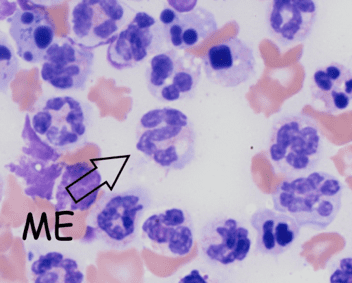
It wouldn’t even be the bacterial toxins that finished me off. My uselessness in the face of the enemy and danger to my fellow neutrophils and surrounding tissues would be quickly recognised, and I would end my brief time in the front line of the immune system here:
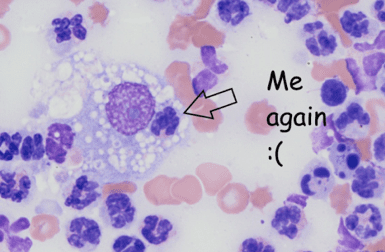
Here I am, rapidly digesting in the belly… well, cytoplasm… of one of the big guns of the immune system. I know in my heart that I would be a neutrophil, but I would dream of being a macrophage.
That huge shoggoth-like mass of cytoplasm currently consuming the Nickocyte is one of them, and they do not mess about – I mean, their name literally means “big eater”. These giant protoplasmic blobs are not the one-shot warriors that neutrophils are; they can keep munching away for weeks – months, in some locations.
Superheroes
There’s a debate we occasionally have in the lab – if neutrophils are the foot soldiers, what are macrophages? Are they the tanks? Artillery support? Super soldiers? The honest answer to the question (other than “why are you wasting your time talking about this when there’s work to do?”) is that none of them quite fit.
You see, they don’t just slither around the battlefield laying waste to everything they meet like the titular monster in the classic 1950s B-movie The Blob (which, incidentally, had the most bizarrely inappropriate upbeat theme song for a horror film I’ve ever heard) – macrophages are far more than just “big eaters”:
- they coordinate the other leukocytes using secreted chemicals (cytokines)
- they clean up the mess of dead cells and damaged tissues
- they help to stimulate more tailored immune responses by taking pieces of the invading organisms and presenting them to lymphocytes
- they even help with healing once the battle is over
Macrophages aren’t just tanks – they’re also generals, cleaners, intelligence officers and medics. They’re multifunctional immune superheroes; they’re the entire Avengers rolled into one. They’re wonderful.
They’re also a real bugger if you’re a cytologist.
Masters of disguise
The consequence of this immense, monstrous plasticity is that macrophages have a highly varied appearance. In their inactive state they’re a relatively bland, if large, round cell with a round nucleus in the middle, but once they’ve been trigged they vary greatly in colour, size, shape, and even number of nuclei… very much, in fact, like cancer cells do.
Here are some examples:
The macrophages below are angry. They’re angry because they’ve been activated for some time and they still haven’t managed to get rid of the inflammation. When macrophages get angry, they change colour. Unlike the Hulk, they don’t turn green. Instead, the build up of organelles and products in their cytoplasm makes them turn a deep, frustrated, blue.
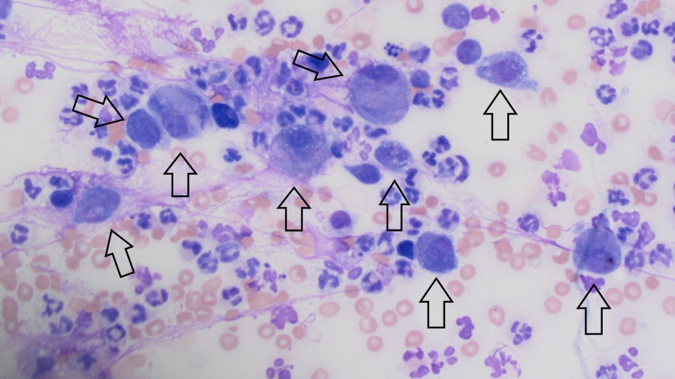
See how they vary in shape, size and amount of cytoplasm? That’s something that cancer cells like to do, too.
Here’s why they’re angry:
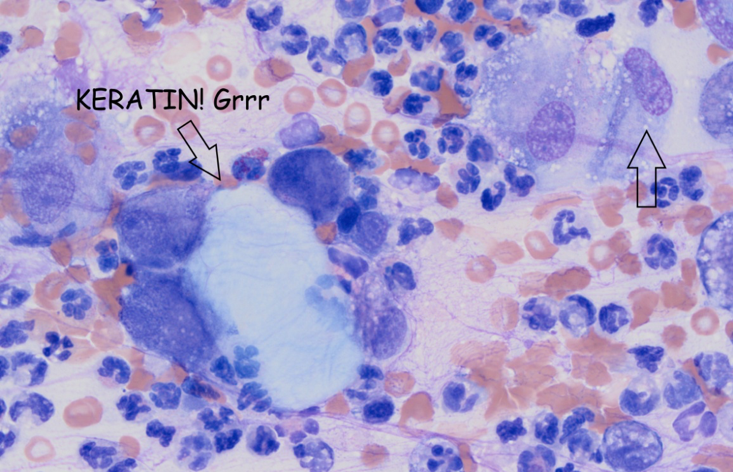
The pale blue rounded stuff is keratin, probably released from a ruptured hair follicle cyst – it is very irritant and extremely hard to digest. It’s annoyed the macrophage on the right so much that he’s grown another nuclei to try to deal with it… another thing that cancer cells are fond of doing.
How about this lot?
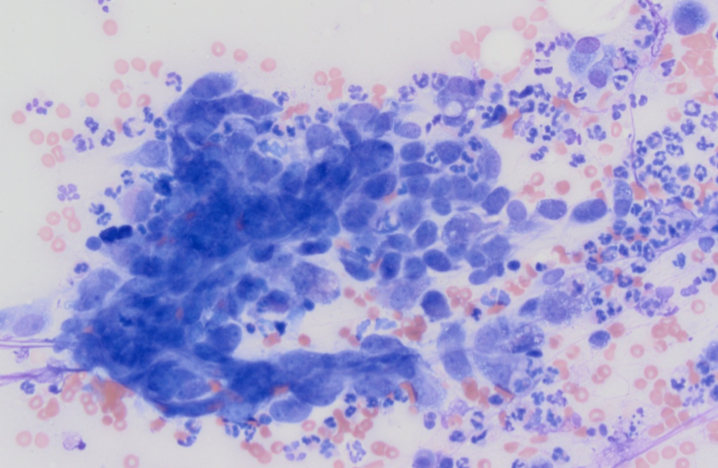
These macrophages are so sick to death of the keratin that they’ve teamed up to try to fight it. The big clump of cells are “epithelioid macrophages” – a group of big eaters that are attempting a coordinated chemical assault, secreting all manner of cytokines in an effort to bring some order to the chaos of the battlefield (although there are some larger rogue cells on the right of the picture that are munching away at some neutrophils; either they’re trying to clean up or they’re just really pissed off).
The problem is that… well, there’s a clue in the name. Epithelioid macrophages look like clusters of epithelial cells. Specifically, they look like very badly-behaved epithelial cells – carcinomas.
Respect and admiration
As a cytologist, it takes quite some time to get used to macrophages, and to feel relaxed when looking at them. Just when you think you understand the range of their behaviour, you find one that has got so annoyed it’s developed 30 nuclei, eaten an entire battalion of neutrophils, or has managed to swallow something you’ve never seen before on any slide, let alone inside a leukocyte.
Ahh, macrophages – they fool me on a daily basis. I respect them and I admire them (and I’m slightly scared of them). But I know, deep in my soul, that I could never be one.

Leave a Reply